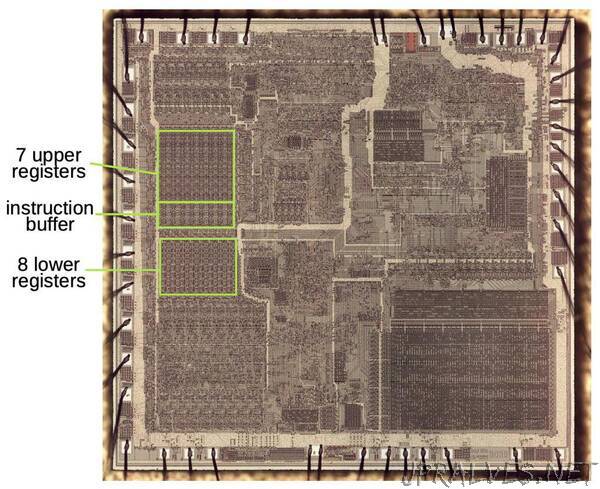
“The Intel 8086 microprocessor is one of the most influential chips ever created; it led to the x86 architecture that dominates desktop and server computing today. I’ve been reverse-engineering the 8086 from die photos, and in this post I discuss how its register file is implemented.
The photo above shows the silicon die of the 8086 processor under a microscope. The metal layer on top of the chip is visible, with the silicon hidden underneath. Around the outside edge, bond wires connect pads on the die to the chip’s 40 external pins.
The highlighted region indicates the 8086’s fifteen 16-bit registers and six bytes of instruction prefetch queue.1 Registers take up a significant portion of the die, even though they are just 36 bytes in total. Due to space limitations, early microprocessors had a relatively small number of registers; in comparison, a modern processor chip has kilobytes of registers and megabytes of cache storage.2
How a register is implemented in silicon
I’ll start by explaining how the 8086 is built from NMOS transistors. Then I’ll explain how an inverter is constructed, how a single bit is stored using inverters, and how a register is constructed.
The 8086 and other chips of that era were built from a type of transistor called NMOS. These chips consisted of a silicon substrate, which was “doped” by diffusion of arsenic or boron to form transistors. Above the silicon, polysilicon wiring created the gates of the transistors and wired components together. Finally, a metal layer on top provided more wiring. (Modern processors, in comparison, use CMOS technology, which combines NMOS and PMOS transistors, and they have many metal layers.)
The schematic below shows an inverter built from an NMOS transistor and a resistor3 With a low input, the transistor is off, so the pull-up resistor pulls the output high. With a high input, the transistor turns on, connecting ground and the output, pulling the output low. Thus, the input signal is inverted.”
